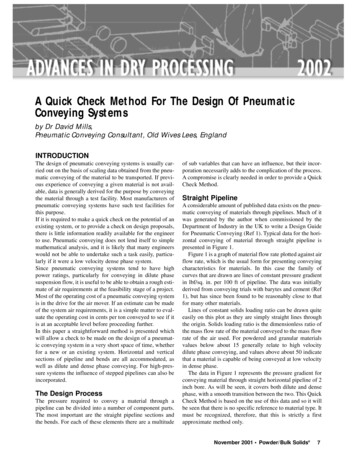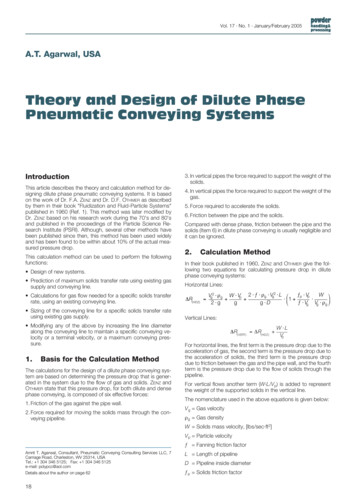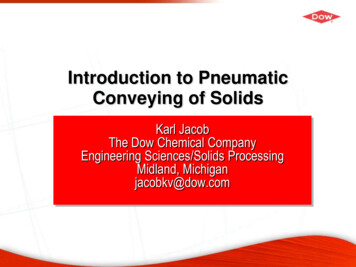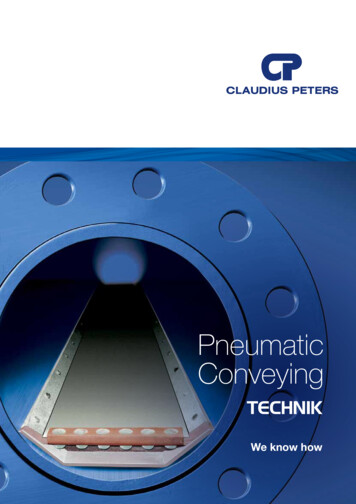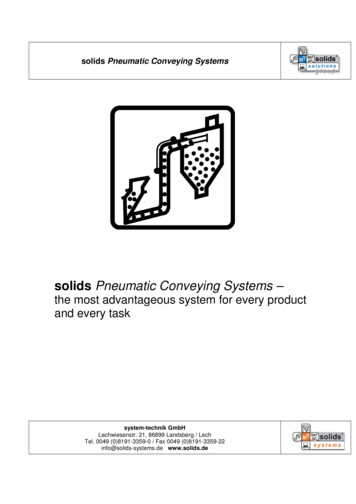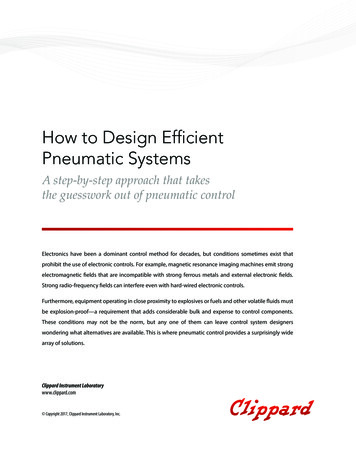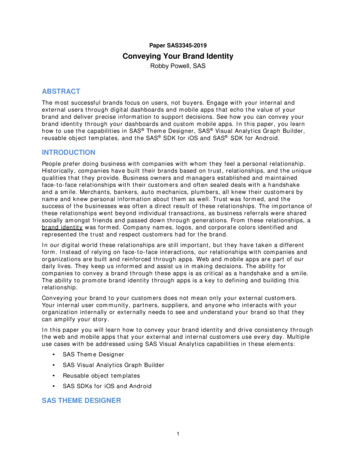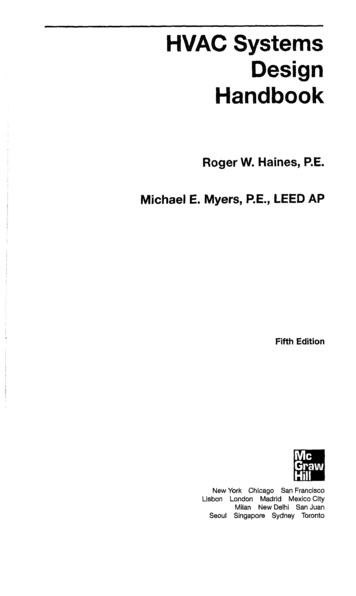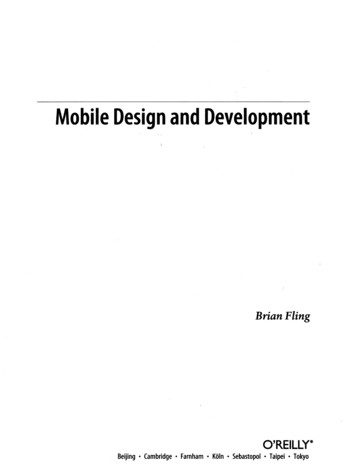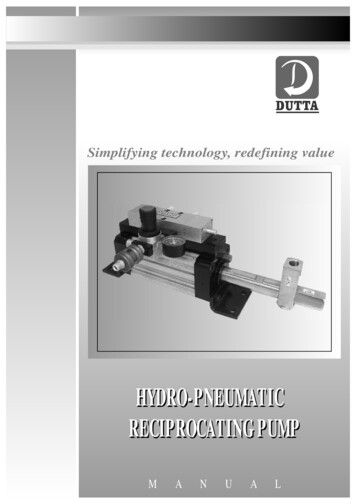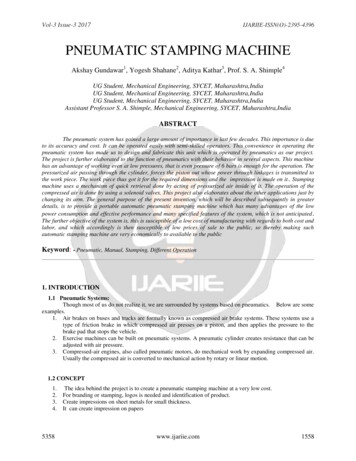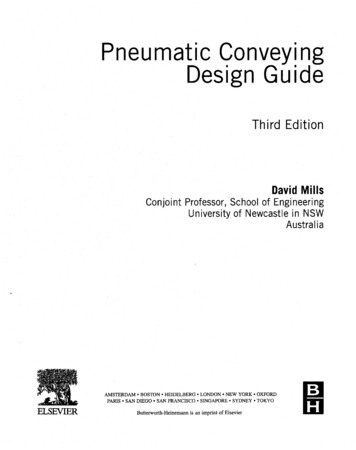
Transcription
Pneumatic ConveyingDesign GuideThird EditionDavid MillsConjoint Professor, School of EngineeringUniversity of Newcastle in NSWAustraliaAMSTERDAMPARIS BOSTONSAN DIEGO HEIDELBERG LONDONSAN FRANCISCO SINGAPORE Butterworth-Heinemann isanimprint NEW YORK OXFORDSYDNEY TOKYO of ElsevierBH
ContentsxxiiiPreface to the Third EditionPART A CONVEYING IN PIPELINESCHAPTER 1Introduction to PneumaticConveying and the Guide35IntroductionPneumatic6ConveyingSystem Flexibility6Industries and Materials6Mode of8ConveyingDilute Phase8Dense yLoadingRatio1011Conveying CapabilitySystem Types11System Capabilities12High-Pressure Conveying13Long-Distance Conveying14Vertical Conveying15Flow Rate15CapabilityInformation ProvidedAvailabilityScope ofofDesign16Data16the WorkReview of ChaptersConveyingin161717PipelinesAirflows and Particle Flows17A Review of Pneumatic18ApplicationsandConveying SystemsCapabilities18Conveying System Components18Gas and Solid Flows19Conveying System Design21Conveying System Operation2224DefinitionsConveyingVelocity Related24Properties28and Systems26V
viCONTENTSNomenclatureCHAPTER 229Symbols29Greek30Nondimensional Parameters30Superscripts30Subscripts31Reference Points31Prefixes32Reference32Airflow and Particle Flow in ity35Evaluation ofSingle35Phase Flow3637Slip VelocityParticleFeedinginto38PipelinesAcceleration Pressure39DropConveying Air Velocity ProfileParticle Deposition IssuesFlowThrough PipelineMode of FlowSolids3940Bends4344Though PipelinesRatioLoading45Dilute Phase Flow45Dense Phase Flow46Transitional47RelationshipPlug-Type FlowPipeline ity48Evaluation48Effects49The Influence of Pressure49The Need forMaterialConveying DataDegradation Influences5353Mean Particle SizePipeline54Material55Sources of DataReferencesCHAPTER 3AReview of Pneumatic Conveying Systems56 5759Introduction.!60System Types60
CONTENTSOpen Systems62Staged Systems64Batch65Conveying SystemsMobileSystems67ClosedSystems69Innovatory Systems69Pressure72DropConsiderationsFluidized MotionConveying SystemsThe Geldart Classification of Fluidization BehaviorSystem RequirementsMultiple-Point PickupMultiple-Point DeliveryMultiple PickupandDelivery737476767676Multiple Material—Type Handling77Multiple Distance ConveyingConveying from Stockpiles77Start-UpMaterialwith tive80Toxic80VeryFine80ReferencesCHAPTER roductionPerspective82System Flexibility82Industries and Materials82Flow Rate83CapabilityPressure Gradient InfluenceConveyingVerticalDistanceConveying848588
viiiCONTENTS91ApplicationsHigh-Pressure Delivery Capability91Multiple-Distance ConveyingMultiple-Material 0PART B CONVEYING SYSTEM COMPONENTSCHAPTER 5Pipeline Feeding Devices103Introduction104Selection Considerations105Devices Available106Feeding 109Valve WearAlternativeDischarge PeriodAir109Designsand PulsationsIllLeakageRotor115TypesHigh-Pressure RotaryValvesMaterial Feed RateSimple117117118Screw FeedersThe110Screw FeederHigh-Pressure DesignVenturi Feeders118119120Commercial Venturi Feeder121Flow Control121Gate-Lock Valves122Suction Nozzles124Feed Rate Control125Flow Aids126Hopper Off-Loading126Vacuum-Aerated Feed Nozzle127Trickle Valves127Blow Tanks128Basic Blow Tank Types128Top and Bottom Discharge129FluidizingMembranesBlow Tank PressureDrop132132
CONTENTSProblems with Moisture133Road and Rail Vehicles133Blow-TankSingleBlow Tanks with133SystemsBlow Tanks withoutaaDischargeDischargeValveValve137139Blow Tank Control141SystemsSystemsBlow-Tank Aeration143146References147Air Supply Systems149Introduction150Types of Air MoverAerodynamic ement Compressors153Sliding-Vane Rotary Compressors156Liquid Ring rocating Compressors159Rotary159StagingSpecificationof Air MoversBlowers and159CompressorsExhausters and VacuumAirCompressionPumpsEffects160160161Delivery Temperature161Oil-Free Air163Water ecooling SystemsCHAPTER 7133The Influence of Blow Tank TypeTwin Blow-TankCHAPTER 6ix165167168Reference168Gas-Solid Separation Devices169Introduction170Separation erationsDust Control170170170171Particle Degradation171Dust Emission171
xCONTENTSDevicesSeparation172Gravity Settling ChambersCyclone SeparatorsFilters173176Filtration Mechanisms176Filter Media176BagFilters177Filter erationsBlow Tank180180SystemsVacuumConveying SystemsReferenceCHAPTER 8172180181Pipelinesand Valves183Introduction184Pipelines184Wall 191Vent Line Valves191Flow Diversion192Rubber Hose194Erosive Wear and Particle Degradation194Pressure194DropConveyingCohesive MaterialsReference195195PART C GAS AND SOLID FLOWSCHAPTER 9Airflow Rate etric Flow Rate200The Influence of201VelocityCompressibility ofAir202
CONTENTSVolumetric Flow RatePresentation of203EquationsThe Influence ofPipeBore203205The Influence of Pressure207208DeterminationVelocity209Stepped Pipeline Systems212Location212StepDilute PhaseConveying213Dense PhaseConveying214Vacuum215ConveyingPipeline StagingPipeline Purging216217Air ExtractionThe Influence ofConveyed219Temperature219Material Influences221The Influence of Altitude224PressureAtmospheric224The Use of Air Mass Flow Rate225Air-Only DropFlow Parameters andPropertiesPressureDrop RelationshipsVenturi re ApplicationsAirflow Rate Control228231239241242242Nozzles242Orifice Plates246FlowRate ControlStepped PipelinesCHAPTER 11203The Ideal Gas LawSystem InfluencesCHAPTER 10xi246246References248Conveying ristics250ConveyingMode251
xiiCONTENTSSinglePhase FlowThe251Darcy Equationfor Pressure251DropThe Use of Air Mass Flow Rate252Gas—Solid Flows253The Influence ofEvaluation veyingConveying Air Velocity EffectsSolids Loading Ratio256257The Determination of Conveying CharacteristicsInstrumentation and Control259259Presentation of ResultsDetermination of MinimumEnergyConveying ConditionsConveying CharacteristicsConsiderationsThe Influence ofPowerConveyingVelocity268268Down270Conveying Vertically UpHorizontal PipelinesPipeline Bends271271Conveying Capability273Introduction274274The Influence of Materials1274Low-Pressure Conveying—Part 2278Low-PressureCHAPTER 13264266Drop RelationshipsConveying VerticallyCHAPTER 12264266Specific PlanExperimentalThe Use of253VelocityConveying—PartHigh-Pressure Conveying—Part1281High-Pressure Conveying—Part2287Material Property Influences289Introduction289290Conveying ModesDense Phase Sliding Bed Flow292Dense Phase295PlugConveying CapabilityBasicFlowCorrelationsProperty ClassificationsAeration Property Classifications297298300
CONTENTSMaterial Grade HAPTER stems that Modify Material Properties317Introduction318Wear ProblemsMaterial318DegradationProblems318Product Flavor Problems318Power319RequirementsResearch Work319Conveying Data319Research Test Facilities319Test Data321Material esting328Innovatory SystemsPlug Forming Systems329329Bypass Systems331Air333Injection SystemsPerformance334ComparisonsMaterial ClassificationCHAPTER 15xiii339References339System Selection Material Considerations342Pipeline Geometry344VariablesInvestigated345The Influence of Material345TypeThe Influence ofConveying-LinePressureThe Influence ofConveying DistanceThe Influence of Pipeline meter CombinationsPipeline Conveying CapacityDrop347349352353354354358
xivCUN I LN ISPowerRequirements361Influence of Conveying Distance362Influence of364PipelineBoreMaterials with Good Air RetentionMaterials with Poor Air bility365366Selection ConsiderationsSummary365Charts366366Materials Capable of Dense Phase Conveying367Alternatives to Dilute Phase Conveying368PART D CONVEYING SYSTEM DESIGNCHAPTER 16Pipeline ScalingParametersIntroduction372Scaling RequirementsConveying Air 375BoreEmpty-Line379PressureDrop380Scaling ModelScaling Procedure380Bends386Pipeline381Equivalent ing Vertically Up394Conveying Vertically395DownInclined PipelinesPipeline395Material396Rubber HoseCHAPTER n402The Use ofinEquationsSystem DesignLogic Diagram for System DesignLogic DiagramforSystem Capability403403411
CONTENTSThe Use of Test Data in414System DesignLogic Diagram for System DesignLogic Diagram for System CapabilityThe Influence ofConveying DistanceThe Influence of417Pipeline418418Bore421CurvesDesignCHAPTER 18414and Material InfluencesTypical Pipeline426Stepped Pipelines431Introduction432Conveying Air VelocityCompressibility433of Air StepLocationDilute Phase434435Stepped Pipeline Systems435Conveying436Dense line Staging439Pipeline Purging439StepDense PhaseConveying440ConveyingPerformance441Fine Fly Ash441Existing SystemsApproximation Design444Pressure445FirstDropPressure and444ElementsVelocityProfiles447Cases Considered448Air Extraction454Comparative454PerformanceAirflow Rate nes VerticallyDownCase459460ReferencesCHAPTER 19xvStudy1: A Fine MaterialIntroductionDense Phase461462Conveyingof Cement462Data462Conveying DutyConveying Capability463Conveying464
XVIUUIN I tIN lbSummary465Design ingCHAPTER 20Point Equivalent Lengths468Scaling469forLengthScaling for Bore470AirRequirements471Study 2: A Coarse Material473CaseIntroduction474Dilute PhaseConveyingofMagnesium SulphateConveyingConveying DutyConveying CapabilitySummaryData for Material474475476476476Design re477Operating Point477Air-Only Pressure DropEquivalent erCHAPTER 21466RequiredSpecific Cost483Solids483First483Loading RatioApproximation d485486Methods 87488Empirical Relationships489Working Relationships490
CONTENTSUniversalConveying CharacteristicsStraight re495Stepped Pipelines495Pipeline495BendsMinimum Conveying Air VelocityCHAPTER 22496Computer-Aided Design Programs502Reference503Multiple Use dlingSupply Control508Material Flow ControlMultiple Delivery508Points508Material InfluencesThe Use of510510Stepped PipelinesFlour andCHAPTER 23xvii510SugarAlumina514Pulverized Fuel Ash515Step Location519Applications of Numerical Modeling in Pneumatic Conveying.521Introduction522Multiphase Modeling Methodology523Eulerian-Based Methods523The Volume of Fluid Model523Lagrangian-Based527Momentum Transfer and TurbulenceInterphaseModelingMomentum 37Velocity Boundary Conditions537Application ExamplesMultiphase ComputationalFluidDynamic StudyConveying Pipeline of Fine PowdersCoupled Computational Fluid Dynamic 1of Dilute Pneumatic538ElementConveying Pipeline544551
xviMGUN I LN ISPART E CONVEYING SYSTEM OPERATIONCHAPTER 24Troubleshooting and Material Flow Problems555Introduction556Pipeline Blockage556GeneralOnCHAPTER 25556Commissioning557Pipeline LayoutOn Start-up566After571a567Period of TimeWith New Material573With574of DistanceChangeOptimizingandUprating of Existing Systems577Introduction577Optimizing Conveying ConditionsModifying Plant erialFeedingSystem578of579579Duty580Air Filtration580Reduce Airflow Rate580Optimizing Existing Systems580Control and Instrumentation581Feeder Considerations581The Use of582Off-TakeCaseaSightGlass582SystemsStudy583The Influence ofThe Influence ofChanging Airflow RateChanging Pipeline DiameterAlternative Methods of584588590Uprating591Pipeline FeedingPipelineAirCHAPTER 26Modifications592Pressure593SupplyGeneral Operating Problems595IntroductionExistingTypesof596Plant ure Systems597597
System ComponentsBlow TankSystems600601Blowers601Blow Tanks601ValvesRotary604Filters606Vacuum 09Electrostatics609Erosive Wear609ExplosionsPipeline Purging610Plant ationsMaterial Related612Pipelines612Cohesive Materials613Consolidation of Materials613Degradationof Materials613Granular Materials613Hygroscopic Material Grade615Temperature615WetCHAPTER 27xixMaterials616Erosive Wear617Introduction618Data Sources618Issues ConsideredInfluence of VariablesImpact Angleand Surface Material619619619Velocity620Particle Size622
xxCONTENT
PneumaticConveying DesignGuide. Third Edition. David Mills. Conjoint Professor,School ofEngineering Universityof Newcastle inNSW Australia. AMSTERDAM BOSTON HEIDELBERG LONDON NEWYORK OXFORD PARIS SANDIEGO SANFRANCISCO SINGAPORESYDNEYTOKYO. Butterworth-HeinemannisanimprintofElsevier. B H. Contents. Prefaceto theThirdEditionxxiii.
